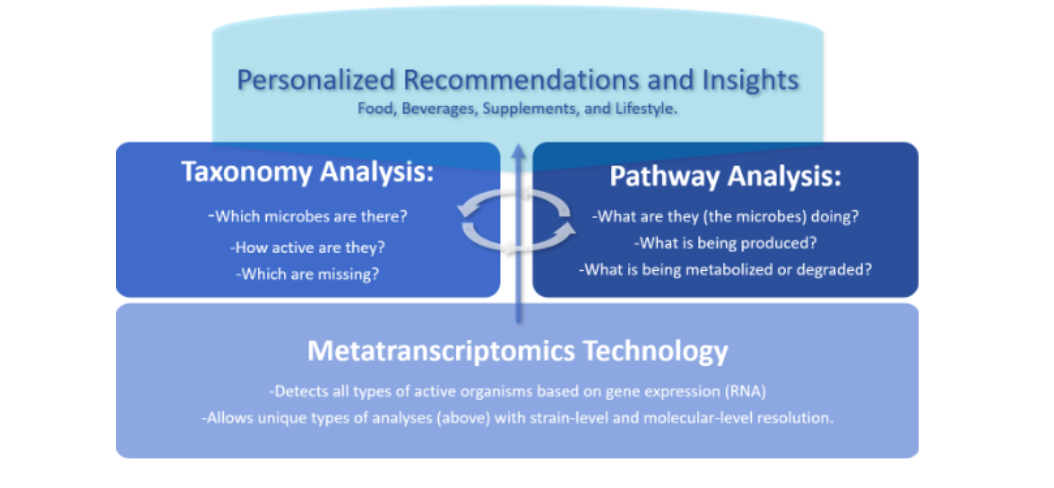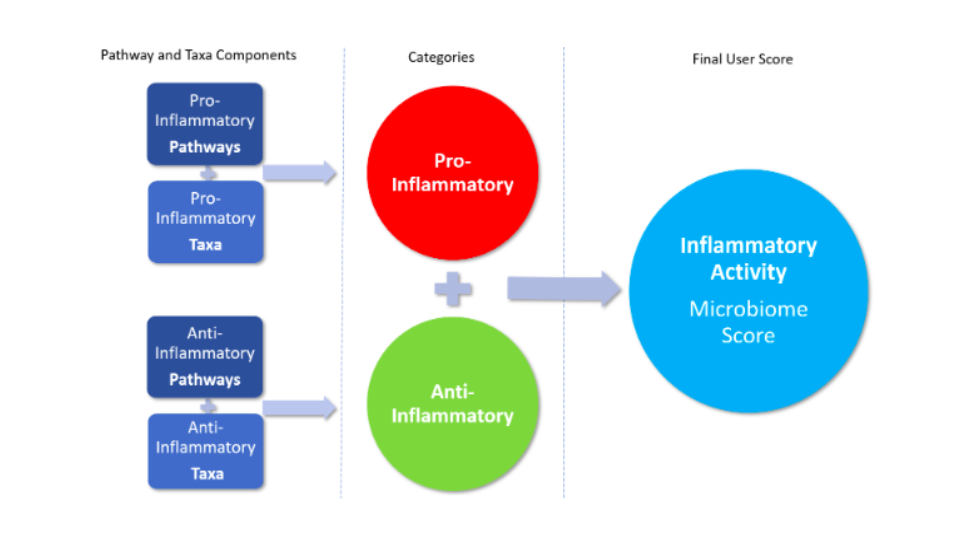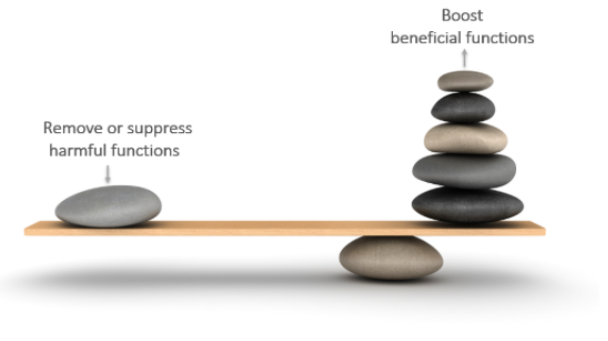You've received your Viome test results… Now what?
Going through your app or website screens you might find yourself wondering – How did we get all those scores and why do they matter?
Many keywords are defined in the app, and the results offer a brief explanation each, but here we are going to talk about how these different pieces are tied together.
We are excited to share with you the scientific vision behind your Viome scores.
We See It – Therefore It’s Active!
One of the reasons the word “active” or “activity” shows up so frequently in Viome’s app and web content is this:
Our unique laboratory technology, called metatranscriptomics, sequences RNA (not DNA) from each sample. Making RNA from DNA is called “transcription.” You can get DNA even from dead organisms, but only live organisms can be actively transcribing RNA. Viome focuses on the live organisms, so just the mere fact that we are able to detect transcription of something means it is alive and active in your gut!
Viome Focuses on What the Microbes Are Actively Doing
Our high-resolution technology allows us to see down to strain-level how active any bacteria, archaea, eukaryotes, and viruses are in your gut and what metabolic and signaling pathways are being activated and to what degree – in other words, what your microbes are doing. When you see the phrase, “Pathway Activity,” it’s referring to what your microbes are actively doing.
What your microbes do in the colon depends on:
- What we give them (like components found in foods and drinks, etc.)
- What we expose them to in the gut environment, like toxins, or substances of our digestive system (bile acids, cholesterol, etc.).
To see this information and tell you what happens next, we identify and examine pathways. These biological pathways are sequences of molecular events that tell a story, step-by-step, from beginning to the end. For example:
- Which beneficial products might be made by your microbiome and from what materials?
- What are your microbes busy processing or degrading?
- What kinds of signals are they communicating to each other and to you?
- What are your microbes using for energy?
- Which carbohydrates are they consuming; glucose or fructose, or more complex starches?
- Which microbial activities may be harmful to you?
- What do the microbes reflect about your diet and your GI environment?
You may be familiar with more famous pathways like Glycolysis or the Krebs Cycle (a.k.a. TCA cycle). These are essentially some of the processes of turning foods into energy. These are some examples of what pathway analysis shows us. Details like this give us a clearer picture of what’s really happening.
How Your Scores Are Derived
When we take a closer look at how your Microbiome Profile scores are derived, you will be able to see these two components that we always strive to incorporate into our scoring:
- Pathway Analysis: Biological pathway activity levels – this is what offers insights into what the microbes are actively “doing.”
- Taxonomy Analysis: The active organisms – who they are, what are they known for, and how active they are in your sample.
 Having both taxa and pathway perspectives allows us to further personalize the resulting insights and recommendations.
Having both taxa and pathway perspectives allows us to further personalize the resulting insights and recommendations.
Viome’s app shows the following Pathway Analysis Scores:
- Butyrate Production Pathways
- LPS Biosynthesis Pathways
- Methane Gas Production Pathways
- Sulfide Gas Production Pathways
- Flagellar Assembly Pathways
- Ammonia Production Pathways
- Putrescine Production Pathways
- Oxalate Metabolism Pathways
- Uric Acid Production Pathways
- Salt Stress Pathways
- Biofilm, Chemotaxis, and Virulence Pathways
- Bile Acid Metabolism Pathways
- TMA Production Pathways
No other company can see with molecular-level precision what’s going on in the gut microbiome from this functional viewpoint. Without this perspective, it would be very hard to predict what your microbes are actively doing to each other and to you – the host. We also have a clearer picture of how you're affecting the health of your gut and your gut microbiome – whether you’re being a “good host” and what you can do to improve.
Making a comprehensive microbiome assessment to create meaningful scores for related wellness, diet, and supplement recommendations is like building an architectural feat that has never been done before, brick by brick. This Translational Science effort is what allows the information gathered to play a valuable role in your personal wellness journey.
Viome’s app shows the following Microbiome Profile Scores:
Besides the scores that mostly focus on molecular or pathway level functions, we also compile aggregate integrative scores that assess broader functional profiles or patterns of functional activities. They include many different pathway and active taxa (microbe species) scores with different levels of impact based on scientific literature relevance.
- Inflammatory Activity
- Metabolic Fitness
- Microbial Richness
- Digestive Efficiency
- Intestinal Barrier Health
- Overall Gas Production
- Protein Fermentation
We do not test any metabolites or chemical compounds themselves, but we do evaluate various microbial activities and functions with our metatranscriptomics technology.
Depending on which component of the score is out of balance, and by how much, your overall Microbiome Profile Score and recommendations may change.
When you retest your gut microbiome, we can then review and compare the activity of each functional category.
To develop our scores we:
- Examine expressed genes that have known molecular functions →
- Then we unravel the stories as a result of analyzing the various pathways that give insights into your microbiome functions →
- Which finally tells us about overall wellness and health-related functions.
Microbiome Profile Score Descriptions

Inflammatory Activity
This score measures all the activities of your microbes that can contribute to or reflect inflammation in your gut environment. Inflammation in your gut can be caused by harmful things your microbes produce when you are either inefficiently digesting your proteins, have excessive microbial gas production, or simply have a gut environment that your microbes perceive as threatening. A score that needs improvement means that there are relatively more pro-inflammatory activities, as opposed to anti-inflammatory or protective ones. Everyone's pattern is unique, so if your score needs improvement, some of your recommendations may focus on boosting more of the protective and healing anti-inflammatory functions, while others may focus more on controlling and balancing out the more harmful pro-inflammatory microbes and functions. Follow your recommendations to maintain or improve this score.
Metabolic Fitness
This score represents active microbial organisms and functions that are associated with your blood sugar, insulin resistance, or weight control. Your metabolic fitness score compares the activity of both metabolic-healthy and metabolic-unhealthy microbes. A good score means high activity of microbes and their functions favorably associated with your metabolic fitness. A Metabolic Fitness score that indicates the need for improvement does not necessarily mean weight loss or gain. Follow your recommendations to support or improve healthy metabolic functions.
Microbial Richness
The score is your percentile for total count of active microbial species detected and sequenced from your sample. A good score means there is more richness, which in turn can provide more resilience to your microbial gut ecosystem and your body. This score needs improvement when the count of active microbes is relatively low and your gut flora could use additional microbes in its active composition. Your recommendations may include certain supplements or fermented foods that address this score.
Digestive Efficiency Score
This score review a culmination of protein fermentation, motility/gases, intestinal barrier health, and SIBO-like/hypo-HCL pattern scores to assess the overall efficiency of your digestion. Everyone’s pattern of Digestive Efficiency (or inefficiency) is unique and must be addressed individually via our personalization logic, which rebalances the active functions of your unique microbiome related to various areas of digestion.
Intestinal Barrier Health
This score focuses on your gut lining (or intestinal barrier) and the health of the mucosal layer that protects it. When your gut lining is compromised, things from the outside environment, like toxins, medications, and harmful bacteria, can make their way into your bloodstream from your gut and negatively affect your immune system and overall well-being. A good score means more optimal microbial functions that support your intestinal barrier and fewer disruptive or harmful functions are active in your gut. Follow your recommendations to address your specific pattern of microbial functions, and to prevent any intestinal permeability known as 'leaky gut.'
Overall Gas Production
This score is an assessment of your overall gas production activity by the microbes in your gut. Overall high microbial gas production has been associated with digestive difficulties, discomfort, and gut inflammation. A good score means that your microbes are not actively engaged in gas production functions.
Protein Fermentation
This score reflects whether or not you are digesting your proteins properly. Protein digestion begins when you first start chewing and continues down in your stomach. If the protein is not fully broken down through this process, your microbes will digest the excess protein available and may convert it into harmful byproducts. Overly high microbial protein fermentation translates into a score that needs improvement suggesting your protein digestion is suboptimal.
Pathway Score Descriptions
Butyrate Production Pathways
This score assesses the levels of activity of all microbial pathways that lead to the production of a beneficial nutrient called butyrate. Butyrate is a short-chain fatty acid known to improve many wellness areas from gut lining to insulin sensitivity and satiety (feeling full). A score that needs improvement means that your microbial butyrate production could really use a good boost! Two butyrate scores integratively yield different recommendations personalized for you, suggesting to either “add good guys” (via more sources of beneficial butyrate producers, like probiotics or fermented foods) or “feed the good guys” (give the butyrate producers what they need to make more butyrate, like inulin prebiotics or foods like artichoke), and/or balance your microbiome in other ways to support the butyrate production.
LPS Biosynthesis Pathways
This score assesses the levels of activity of all microbial pathways leading to the production of LPS (lipopolysaccharides) in your gut. LPS is a proinflammatory molecule that gut microbes can make, which can trigger your immune system response, especially if it passes to the bloodstream through the gut lining. This score is an important factor in assessing your inflammatory activity patterns.
Methane Gas Production Pathways
This score assesses the levels of activity of all microbial pathways that result in giving off methane gas in your gut. This kind of activity, when high, has been linked with some motility issues in the gut (how your food moves along the digestive tract), as well as pro-inflammatory patterns that can negatively affect your intestinal lining. A good score means that the activity of methane production pathways is low.
Sulfide Gas Production Pathways
This score assesses the levels of activity of all microbial pathways that result in the production of hydrogen sulfide gas. It can be made from some proteins that contain sulfur amino acids or from ingested sulfate or sulfite molecules found in foods like dried fruit, preserved meats, and some alcoholic beverages. This kind of activity, when high, contributes to pro-inflammatory patterns potentially harmful to the gut lining, as well as slowing of your motility (moving the food down your digestive tract). If your score is high, some nutritious foods like cruciferous vegetables may be included in your “Minimize” foods as they can also promote the production of sulfide gas, until your score improved. A good score means that the activity of sulfide production pathways is low.
Flagellar Assembly Pathways
This score assesses the levels of activity of all microbial pathways leading to the making of a structure called flagella. Flagellar structures serve as "fins" or "tails" for various microbes to help them move. A score that needs improvement suggests that these signaling pathway activities are high, indicating unrest in your microbiome as flagellar structures are helping beneficial organisms move away from a perceived threat. Higher than usual activity can also signal the presence of opportunistic organisms that are known to have these flagellar structures. This score is an important factor in assessing your inflammatory activity patterns.
Ammonia Production Pathways
This score assesses the levels of activity of all microbial pathways that result in the production of ammonia. Ammonia gas can be made from amino acids as a byproduct of the breaking down of protein or from ingested nitrate or nitrite molecules found in things like food preservatives or additives used in preserved meats and dried fruit. This kind of activity, when high, contributes to pro-inflammatory patterns potentially harmful to the gut lining, as well as slowing of your motility (moving the food down your digestive tract), and is also one of the signs that your proteins may not be digested properly. A good score means that the activity of ammonia production pathways is low.
Putrescine Production Pathway
This score assesses the levels of activity of all microbial pathways that lead to putrescine production. Putrescine is a molecular byproduct of protein fermentation - a microbial breakdown of protein. If the activities of putrescine production pathways are too high, it can be harmful to the gut environment and the intestinal barrier lining. It is also one of the signs that you may be eating too much protein that may not be digested properly.
Oxalate Metabolism Pathways
This score assesses the levels of activity of all microbial pathways needed to break down or metabolize oxalate. Oxalates are a major contributor to kidney stones. Oxalate-metabolizing microbes can help you by removing and digesting oxalate that you ingested from food. A good score means oxalate-metabolizing activities are high in your microbiome. When this score needs improvement, AND your oxalate metabolizers (microbes) are also not active, you may see some of the foods high in oxalate content on your list to minimize or even avoid.
Uric Acid Production Pathways
This score assesses the levels of activity of all microbial pathways that lead to the production of uric acid (or urate). Uric Acid is a normal byproduct that comes from the breakdown of compounds called purines, which can be found in beer, sugary sodas, seafood and shellfish, turkey, veal, bacon, and organ meats. Excessive amounts of uric acid can contribute to gout. A good score means that your uric acid production pathway levels are low.
Salt Stress Pathways
This score assesses the levels of activity of all microbial pathways that signal excessive salt in the gut environment. This kind of signaling activity, when high, suggests that you may need to adjust your salt or sodium intake and/or your hydration levels. Too much salt for your gut microbiome makes your gut environment less favorable for some beneficial or probiotic organisms to thrive. A good score means that that pathway levels that signal microbial salt stress are low.
Biofilm, Chemotaxis, and Virulence Pathways
This score assesses the levels of all activity of all metabolic pathways that suggest a pro-inflammatory or hostile environment in the gut. This includes virulence factors, biofilm formation, and chemotaxis signaling, which are all important parts of your overall inflammatory activity patterns. When this score is relatively high it means that there is some threat in the environment and your microbes are trying to either defend themselves, attack each other, or move. This type of a "microbial war zone" can negatively impact your gut environment, and some of the "bullets" secreted by the microbes may trigger an immune response. A good score means that these pathway activities are at low levels.
Bile Acid Metabolism Pathways
This score assesses the levels of activity of all metabolic pathways that include bile acids. Normally bile acids are made by the liver and secreted into the small intestine to help with fat digestion. Most are reabsorbed, but small levels of bile acids can enter the colon in the form of bile salts. Your gut microbiota can change them back into bile acids, after which they can even be recycled back to the liver. If this activity is relatively high or excessive, it may be an indicator of your inability to break down fat or absorb nutrients properly, which can contribute to a pro-inflammatory environment or negative liver-related effects, as microbiome's bile acid pathways have been implicated in fatty deposits in the liver. A good score means these pathway activity levels are low in your sample.
TMA Production Pathways
This score assesses the levels of all activity of metabolic pathways that result in TMA production. TMA (trimethylamine) is a molecule that gets converted to TMAO (Trimethylamine N-oxide) in the liver. TMAO is associated with unfavorable metabolic and cardiovascular effects. Since one of the substances used for microbial TMA production is choline, reducing high-choline-containing foods in the diet may be one of the options for improving this pattern. A good score means these TMA production pathway activity levels are low.
Balance your gut microbiome with personalized diet and supplements

Besides the microbiome scoring system, another proprietary Viome approach is in our personalized recommendation logic. This system, Viome Recommendation Engine, or VRE, is designed to address individual’s biological patterns at the functional level (pathways and health-related areas) by boosting beneficial and suppressing harmful activities with foods and supplements.
The way our recommendation logic system works allows many different inputs to “weigh in” integratively for final placement of food into one of the 4 categories:
- Superfood
- Enjoy
- Minimize
- Avoid
Many of our recommendations focus on richness and diversity of your gut microbiome. A resilient microbiome has a wide variety of organisms, each with their own functions. When you have a diverse microbiome, you have a higher number of various species present. Meaning, they can perform a wider range of functions. In other words, you want a high level of richness and diversity.
Robust richness and diversity create an ecosystem of organisms in your microbiome that can withstand stress and promote health.
We do this by making food recommendations that:
- Fuel microbes known to produce beneficial compounds or nutrients
- Encourage your microbes to metabolize compounds in food to get their full benefit
- Minimize foods that may contain potentially harmful components that can't be neutralized by your microbiome
- Promote stabilizing your blood glucose
- Avoid compounds in a certain food that is unfavorable to your microbiome and gut integrity
A food may be beneficial for specific microbiome functions based on the necessary nutrient(s) content. However, if there are any health conditions inferred from the questionnaire or if our Glycemic Response prediction model predicts high glycemic response to this food for the given person, then the food may go on “Minimize” or “Avoid” list. The main reason we take phenotype information into account is to assure we do no harm while we address the biology of the functional systems.
What our customers report
- among customers with 2 or more kits, multiple scores show improvement over time.
- over 80% of Viome customers report following our recommendations.
- 97% of our customers reported feeling the same or better while requesting a retest kit.
